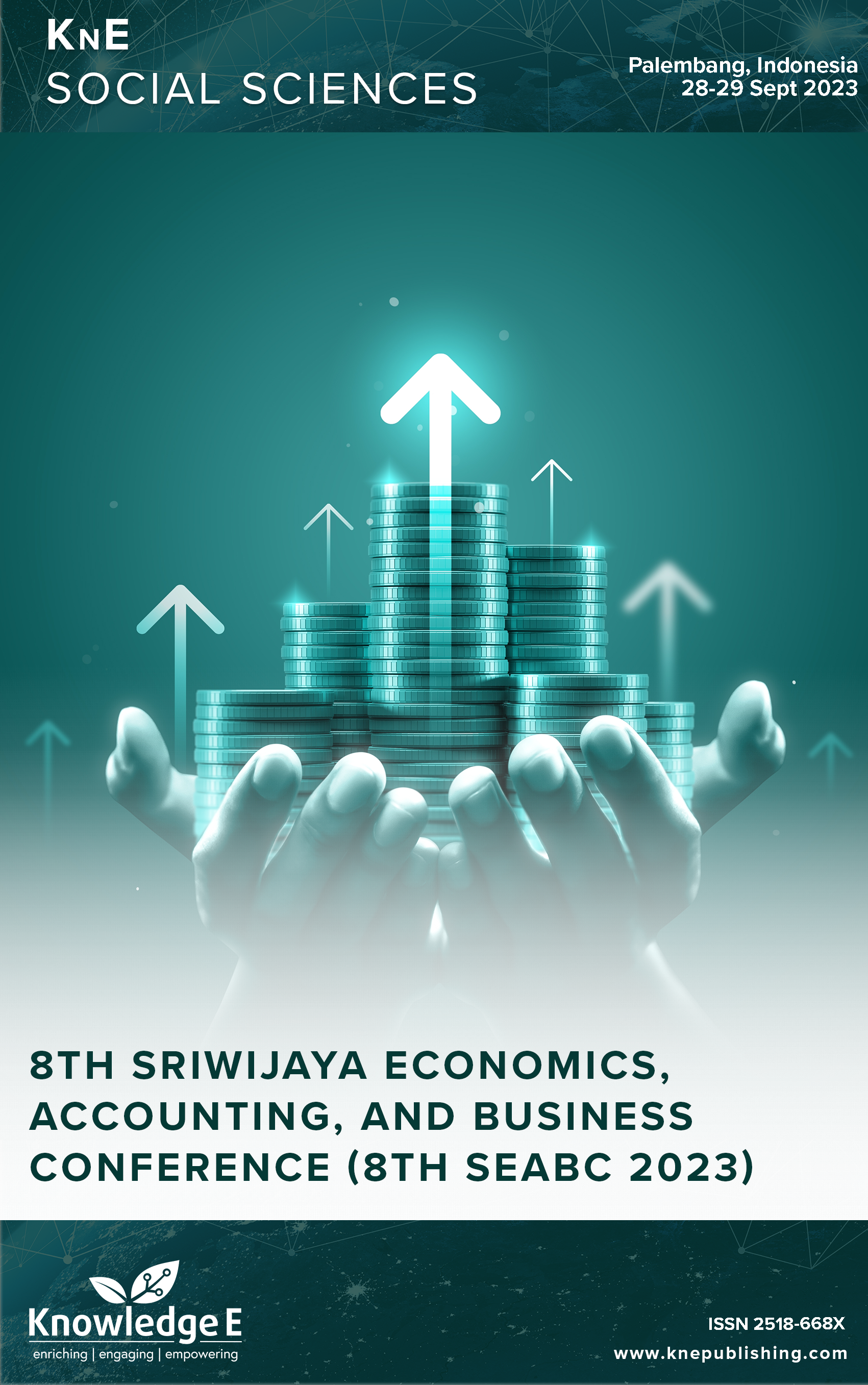Factors Affecting Millennials and Gen Z Preferences in Using Cashless Payment Systems in DKI Jakarta
DOI:
https://doi.org/10.18502/kss.v9i14.16102Abstract
This research aims to determine the effect of perceived usefulness, perceived ease of use, perceived security, income, education level and generation on Millennials and Gen Z preferences in using cashless payment systems and to find out which factors have the most influence. This research is a quantitative research with analytical technique using linear multiple regression. The research uses primary data obtained through the distribution of questionnaires to a sample of 100 respondents. The sampling technique used is purposive sampling with the sample criteria being cashless payment users aged 15–40 years. The research shows that perceived usefulness, perceived ease of use, income, and generation have a positive and significant effect on Millennials and Gen Z preferences in using a cashless payment system. Whereas, perceived security and education level have no effect on Millennials and Gen Z preferences in using a cashless payment system. Perceived usefulness is the factor that most influences Millennials and Gen Z preferences in using a cashless payment system. To increase perceived usefulness and perceived ease of use, providers can improve the service quality of the cashless payment system so that users can access it more easily. To increase the perception of security, Bank Indonesia and the Financial Services Authority (Otoritas Jasa Keuangan) made stricter regulations related to the protection of users’ personal data. To increase the use of the cashless payment system, the providers carry out promotions more often to attract the public’s attention and also carry out socialization to increase public understanding of the cashless payment system.
Keywords: preference, payment systems, cashless, millennials, gen Z
References
Indonesia F. Tentang Kami Fintech Indonesia. 2022. https://fintech.id/id#about-us
Pahlevi R. Survei DailySocial: OVO Jadi Dompet Digital Paling Banyak dipakai Masyarakat. Katadata.
Jayani DH. Proporsi Populasi Generasi Z dan Milenial Terbesar di Indonesia. Katadata Media Netw.
Aeni SN. Inilah Perbedaan Generasi X, Y, Z dengan Dua Generasi Lainnya. Katadata.
Juditha C, Darmawan J. Penggunaan Media Digital dan Partisipasi Politik Generasi Milenial. Jurnal Penelitian Komunikasi dan Opini Publik. 2018;22(2). DOI: https://doi.org/10.33299/jpkop.22.2.1628
Badan Pusat Statistik Provinsi DKI Jakarta. Jumlah Penduduk Provinsi DKI Jakarta Menurut Kelompok Umur dan Jenis Kelamin 2019-2021.
Petriella Y. DKI Jakarta Jadi Model Transaksi Non Tunai. Bisnis.Com.
Transjakarta. Mulai Kamis, 19 Maret 2020 Transjakarta Hanya Melayani Pembayaran Non Tunai – PT Transportasi Jakarta.
Bank Indonesia. Volume dari Pembayaran Non Tunai dan Transaksi Penarikan/Penyetoran.
Rodiah SR, Melati IS. Pengaruh Kemudahan Penggunaan, Kemanfaatan, Risiko, dan Kepercayaan terhadap Minat Menggunakan E-wallet pada Generasi Milenial Kota Semarang. Journal of Economic Education and Entrepreneurship. 2020;1(2):66. DOI: https://doi.org/10.31331/jeee.v1i2.1293
Sari MA, Listiawati R, Novitasari N, et al. Analisa Pengaruh Daya Tarik Promosi, Persepsi Kemudahan, Persepsi Manfaat, Persepsi Keamanan Terhadap Minat Penggunaan E-Wallet. Ekon Bisnis. 2020;18(2). DOI: https://doi.org/10.32722/eb.v18i2.2493
Pratami SW. Pengaruh Faktor Persepsi, Sosial-Demografi dan Keuangan terhadap Preferensi Masyarakat Dalam Penggunaan Alat Pembayaran Non Tunai (Studi Kasus pada Pengguna APMK dan Uang Elektronik di Kota Malang). Jurnal Ilmiah Mahasiswa FEB. 2018; 7(1).
Kotler P, Keller KL, Chernev A. Marketing Management. 16th ed. Pearson; 2021.
Pindyck RS, Rubinfeld DL. Consumer Behavior. Microeconomic. 9th ed. Pearson; 2017.
Permono IS. Perilaku Konsumen. Teori Ekonomi Mikro. Jakarta: Gunadarma; 1994.
Irwan AM. Pengaruh Faktor Psikologis, Pribadi, Sosial, dan Budaya Terhadap Keputusan Pembelian Produk Fashion Secara Online (Studi Kasus Pada Konsumen PT. Lazada Indonesia di Kota Makassar). Jurnal Ilmiah Ilmu Manajemen. 2019;1(2).
Padmawidjaja L, Sutrisno TF, Setiani N. Student preference towards Ovo as a cashless payment facility (study at students of faculty of business in Surabaya City). Jurnal Aplikasi Manajemen. 2020;18(3):548–554. DOI: https://doi.org/10.21776/ub.jam.2020.018.03.15
Davis F. Perceived usefulness, perceived ease of use, and user acceptance. Manage Inf Syst Q. 1989;13(3):319–340. DOI: https://doi.org/10.2307/249008
Elango D, Pimpin S. Consumer’s intention to use a cashless payment application in Thailand. Journal of Research and Multidisciplinary. 2020;3(2).
Mustakini JH. Sistem Informasi Keperilakuan. Yogyakarta: Andi Offset; 2007.
Kamil I. The effect of financial ability, ease and security on behavior of the use of financial technology system. Asian Journal of Economics, Business and Accounting. 2020;46–58. DOI: https://doi.org/10.9734/ajeba/2020/v20i330328
Kinasih BS, Albari A. Pengaruh Persepsi Keamanan dan Privasi terhadap Kepuasan dan Kepercayaan Konsumen Online. Jurnal Siasat Bisnis. 16(1). https://doi.org/10.20885/jsb.vol16.iss1.art3 DOI: https://doi.org/10.20885/jsb.vol16.iss1.art3
Sumadi, Romdhoni AH, Fatakhurrohim. Analisis Faktor Kepercayaan, Manfaat Dan Keamanan Terhadap Minat Penggunaan E-Money Dalam Perspektif Ekonomi Syariah (Studi Kasus Pada Masyarakat di Boyolali). Jurnal Ilmiah Ekonomi Islam. 2022;8(2):2195–2201.
Sumarwan U. Perilaku Konsumen: Teori dan Penerapannya dalam Pemasaran. 2nd ed. Purwokerto: Ghalia Indonesia; 2015.
Chi HHP, Nguyen KT, Quach TD. Factors affecting the choice of cashless payment in Vietnam.
Murari K, Bhatt V, Kumar P. Does socio-demography affect preferences and concerns towards cashless payment? Evidence from the north-eastern region of India. Journal of Payments Strategy and Systems. 2020;14(3). DOI: https://doi.org/10.69554/LSVO4282
Notoatmodjo S. Pendidikan dan Perilaku Kesehatan. Yogyakarta: Rineka Cipta; 2003.
Kurniawan S. Pendidikan Karakter: Konsepsi & Implementasinya secara Terpadu di Lingkungan Keluarga, Sekolah, Perguruan Tinggi dan Masyarakat. Ar-Ruzz Media; 2017.
Pratami SW. Pengaruh Faktor Persepsi, Sosial-Demografi dan Keuangan Terhadap Preferensi Masyarakat Dalam Penggunaan Alat Pembayaran Non Tunai. Jurnal Ilmiah Mahasiswa. 2018;7(1):1–22.
Dimock M. Defining generations: Where Millennials end and Generation Z begins. Paw Res Cent.
Urick M, Hollensbe EC. Toward an identity-based perspective of generations. 1st ed. Routledge: Generational Diversity at Work: New Research Perspectives; 2014.
Sugiyono. Metode Penelitian Kuantitatif, Kualitatif dan R&D. Bandung: Alfabeta; 2014.
Yaokumah W, Kumah P, Okai ES. Demographic Influences on E-Payment Services. Int J E-Bus Res. 2017;13(1):44–65. DOI: https://doi.org/10.4018/IJEBR.2017010103

